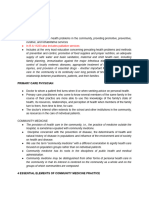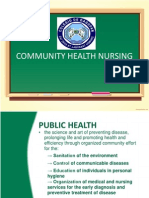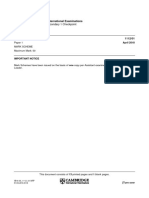0 ratings0% found this document useful (0 votes)
111 viewsRoles and Functions of The Community and Public Health Nurse
Roles and Functions of The Community and Public Health Nurse
Uploaded by
Antoinette RaytonThe document discusses the roles and functions of community and public health nurses. It identifies three core public health functions - assessment, policy development, and assurance - that are foundational to the roles nurses take on at the individual, family, and community levels. The main roles discussed are clinician, which involves holistic and health promotion care, and public health nurse, which focuses on monitoring populations, developing interventions, and advocating for communities. Standards for practice have been established by nursing organizations to guide public health nurses in their important work.
Copyright:
© All Rights Reserved
Available Formats
Download as PPT, PDF, TXT or read online from Scribd
Roles and Functions of The Community and Public Health Nurse
Roles and Functions of The Community and Public Health Nurse
Uploaded by
Antoinette Rayton0 ratings0% found this document useful (0 votes)
111 views27 pagesThe document discusses the roles and functions of community and public health nurses. It identifies three core public health functions - assessment, policy development, and assurance - that are foundational to the roles nurses take on at the individual, family, and community levels. The main roles discussed are clinician, which involves holistic and health promotion care, and public health nurse, which focuses on monitoring populations, developing interventions, and advocating for communities. Standards for practice have been established by nursing organizations to guide public health nurses in their important work.
Original Description:
Describes the roles of nurses
Original Title
Roles of Nurses
Copyright
© © All Rights Reserved
Available Formats
PPT, PDF, TXT or read online from Scribd
Share this document
Did you find this document useful?
Is this content inappropriate?
The document discusses the roles and functions of community and public health nurses. It identifies three core public health functions - assessment, policy development, and assurance - that are foundational to the roles nurses take on at the individual, family, and community levels. The main roles discussed are clinician, which involves holistic and health promotion care, and public health nurse, which focuses on monitoring populations, developing interventions, and advocating for communities. Standards for practice have been established by nursing organizations to guide public health nurses in their important work.
Copyright:
© All Rights Reserved
Available Formats
Download as PPT, PDF, TXT or read online from Scribd
Download as ppt, pdf, or txt
0 ratings0% found this document useful (0 votes)
111 views27 pagesRoles and Functions of The Community and Public Health Nurse
Roles and Functions of The Community and Public Health Nurse
Uploaded by
Antoinette RaytonThe document discusses the roles and functions of community and public health nurses. It identifies three core public health functions - assessment, policy development, and assurance - that are foundational to the roles nurses take on at the individual, family, and community levels. The main roles discussed are clinician, which involves holistic and health promotion care, and public health nurse, which focuses on monitoring populations, developing interventions, and advocating for communities. Standards for practice have been established by nursing organizations to guide public health nurses in their important work.
Copyright:
© All Rights Reserved
Available Formats
Download as PPT, PDF, TXT or read online from Scribd
Download as ppt, pdf, or txt
You are on page 1of 27
Roles and Functions of the
Community and Public
Health Nurse
Upon mastery of this chapter, you should be
•
able to:
● Identify the three core public health functions basic to
communityhealth nursing.
• ● Describe and differentiate among seven different roles of the
community health nurse.
• ● Discuss the seven roles within the framework of public health
nursing functions.
• ● Explain the importance of each role for influencing people’s
health.
• ● Identify and discuss factors that affect a nurse’s selection and
practice of each role.
• ● Describe seven settings in which community health nurses
practice.
• ● Discuss the nature of community health nursing, and the common
threads basic to its practice, woven throughout all roles and settings.
• ● Identify principles of sound nursing practice in the community.
Three primary functions of public
health
• The various roles and settings for practice hinge on
three primary functions of public health:
– assessment,
– policy development,
– and assurance.
• They are foundational to all roles assumed by the
community health nurse and are applied at three levels
of service:
– to individuals,
– to families,
– and to communities
Assessment
• An essential first function in public health
• the community health nurse must gather and
analyze information that will affect the health of
the people to be serve:
– health needs,
– health risks,
– environmental conditions,
– political agendas,
– and financial and other resources
Policy Development
• is enhanced by the synthesis and analysis of
information obtained during assessment.
• At the community level, the nurse provides
leadership in convening and facilitating
community groups to evaluate health concerns
and develop a plan to address the concerns.
• Typically, the nurse recommends specific
training and programs to meet identified health
needs of target populations.
Assurance
• Assurance activities—activities that make
certain that services are provided—often
consume most of the community health nurse’s
time.
• Community health nurses perform the assurance
function at the community level when they
– provide service to target populations,
– improve quality assurance activities,
– and maintain safe levels of communicable disease
surveillance and outbreak control.
Standards for Community Nursing
• Individuals should receive nursing services based
on standards developed by the American Nurses
Association (ANA), such as:
• the Code for Nurses With Interpretive Statements
(1985),
• Nursing’s Social Policy Statement (1995),
• Standards of Clinical Nursing Practice (2nd edition)
(1998a),
• The Scope and Standards of Public Health Nursing
Practice (1999).
Clinician Role
• The most familiar role of the community health nurse
is that of clinician or care provider;
• means that the nurse ensures that health services are
provided not just to individuals and families, but also to
groups and populations.
• Three clinician emphases, in particular, are useful to
consider here:
– holism,
– health promotion,
– and skill expansion.
Holistic Practice
• In community health a holistic approach means
considering the broad range of interacting needs
that affect the collective health of the “client” as
a larger system
• Holistic nursing care encompasses the
comprehensive and total care of the client in all
areas, such as physical, emotional, social,
spiritual, and economic.
Health promotion
• The clinician role in community health also is
characterized by its focus on promoting
wellness.
• Examples include immunization of
preschoolers, family planning programs,
cholesterol screening, and prevention of
behavioral problems in adolescents.
• Protecting and promoting the health of
vulnerable populations is an important
component of the clinician role
Expanded Skills
• With time, skills in observation, listening, communication,
and counseling became integral to the clinician role as it
grew to encompass an increased emphasis on
psychological and sociocultural factors.
• Recently, environmental and community-wide
considerations, such as problems caused by:
– pollution,
– Violence and crime,
– drug abuse,
– unemployment, poverty, homelessness,
– and limited funding for health programs
• have created a need for stronger skills in assessing the
needs of groups and populations and intervening at the
community level.
Role of the Public Health Nurse
• To: Provide input to interdisciplinary programs
that monitor, anticipate and respond to health
problems in population groups for all diseases
or public health threats including bioterrorism
• To: Evaluate health trends and risk factors of
population groups to help determine priorities
forming targeted interventions
Role of the Public Health Nurse
• To:
• Work with the community or specific population
groups to develop targeted health promotion
and disease prevention activities
• To: Evaluate health care services
• To: Provide health education, care, management
and primary care to individuals and families who
are members of vulnerable populations and high
risk groups
Public health nurses integrate
community involvement and
knowledge of the entire population
with the personal clinical
understandings of health and illness
gleaned from the experiences of
individuals and families within the
population.
The nurse working in public health
should be a voice for members of the
community to voice problems and
desires
The public health nurse can apply
her knowledge of strategies to
choose the intervention(s) that meets
the needs of a particular community,
family or individual
The nurse is the agent who translates
and applies the knowledge of health
and social sciences to individuals
and population groups through
specific interventions, programs and
advocacy
He or she also articulates and
translates health and illness
experiences of diverse, often
vulnerable, individuals and families
to the health planners and policy
makers
Standards of practice have been
established by the American Nurses
Association
The Quad Council, made up of four
public health nursing organizations,
has established core competencies
These competencies reflect an
agreement by the Quad Council that
the public health nurse requires
preparation at the baccalaureate
level.
However, in many states nurses
doing public health work are not
baccalaureate graduates.
Even early on, the shortage of
nurses affected the hiring of BSN or
MSN prepared nurses. Public health
departments could not compete with
hospital systems.
The specialist level competencies
require preparation at the Master’s
level in community and /or public
health nursing.
You might also like
- Community Health NursingDocument43 pagesCommunity Health Nursingstellie2592% (71)
- Public Health Nursing: Scope and Standards of PracticeFrom EverandPublic Health Nursing: Scope and Standards of PracticeRating: 5 out of 5 stars5/5 (1)
- Kevin Quashie - The Sovereignty of Quiet - Beyond Resistance in Black Culture-Rutgers University Press (2012)Document68 pagesKevin Quashie - The Sovereignty of Quiet - Beyond Resistance in Black Culture-Rutgers University Press (2012)Anamaria Garzon MantillaNo ratings yet
- Community Health Nursing Process: Prepared By: Ma. Tonnette Aurora T. Tan, R.NDocument33 pagesCommunity Health Nursing Process: Prepared By: Ma. Tonnette Aurora T. Tan, R.NSamantha67% (3)
- History of Community Health NursingDocument35 pagesHistory of Community Health NursingAgung setiawan100% (3)
- Roles and Functions of The Community Health NurseDocument27 pagesRoles and Functions of The Community Health Nursehemihema100% (1)
- Community Health Nursing Process0Document59 pagesCommunity Health Nursing Process0Mukul Thakur100% (1)
- Full LecsDocument91 pagesFull Lecshartb9965No ratings yet
- Lab Community Health Nursing Nur 193Document6 pagesLab Community Health Nursing Nur 193Bryan Lloyd Ballestar RayatNo ratings yet
- Lec 1Document10 pagesLec 1hartb9965No ratings yet
- PFCM TransDocument155 pagesPFCM Transpjqyfqn6yfNo ratings yet
- Overview of Community Health Nursing/Public Health NursingDocument53 pagesOverview of Community Health Nursing/Public Health NursingHeizmaebrizNo ratings yet
- Community Health Nursing: Definition of Terms: 1-HealthDocument14 pagesCommunity Health Nursing: Definition of Terms: 1-Healthمحمد العيسىNo ratings yet
- Introduction TO CHN RepairedDocument79 pagesIntroduction TO CHN RepairedOtaku BoyNo ratings yet
- Capp Activity 2 (Operaña)Document6 pagesCapp Activity 2 (Operaña)Ellayza OperanaNo ratings yet
- Community Health - 4th Yr.Document50 pagesCommunity Health - 4th Yr.Suresh GosalaNo ratings yet
- CHN Lecture June 2012Document27 pagesCHN Lecture June 2012Jordan LlegoNo ratings yet
- Community Health 2 Power PointDocument31 pagesCommunity Health 2 Power Pointmuhirwa SamuelNo ratings yet
- Community Health Nurseing Unit1Document34 pagesCommunity Health Nurseing Unit1SHAFIQ100% (2)
- Community Health NursingDocument14 pagesCommunity Health NursingAprille Kaye TayoneNo ratings yet
- Roles Settings Practice: Community Health NursingDocument67 pagesRoles Settings Practice: Community Health NursingJayalakshmiullasNo ratings yet
- Assignment On Community Health Nursing ProcessDocument11 pagesAssignment On Community Health Nursing ProcessMukul ThakurNo ratings yet
- An Overview of Community Health Nursing PracticeDocument41 pagesAn Overview of Community Health Nursing PracticeWilma BeraldeNo ratings yet
- Historical Development of Community HDocument32 pagesHistorical Development of Community HGoogleaccountNo ratings yet
- Principles & Qualities of Community Health NurseDocument35 pagesPrinciples & Qualities of Community Health NurseHemantNo ratings yet
- Community HealthDocument40 pagesCommunity HealthHigh TechNo ratings yet
- CHN MergedDocument261 pagesCHN MergedRej h100% (1)
- Community-Health-Nursing ReviewerDocument12 pagesCommunity-Health-Nursing ReviewerRica ParcasioNo ratings yet
- Introduction to community health nursingDocument46 pagesIntroduction to community health nursingmalikfaheem1158No ratings yet
- Community As Client: Applying The Nursing Process: Prepared By: DR - Soad AlnassryDocument42 pagesCommunity As Client: Applying The Nursing Process: Prepared By: DR - Soad AlnassryAmnah AbudayahNo ratings yet
- Community Health NursingDocument4 pagesCommunity Health Nursingd-fbuser-68662439No ratings yet
- Prelim 1Document6 pagesPrelim 1Brent Ouen C. PenuelaNo ratings yet
- COPARDocument57 pagesCOPARBernardita Timbreza Hernandez100% (4)
- CHN Ppt. For 3rd Year or 2nd YearDocument27 pagesCHN Ppt. For 3rd Year or 2nd YearMarileth Jefferson100% (1)
- Ch-1 PC4 CON &CBNDocument34 pagesCh-1 PC4 CON &CBNmaha abdallahNo ratings yet
- COPAR LectureDocument57 pagesCOPAR LectureYep Yep100% (3)
- CHCDocument22 pagesCHCBunti ThakurNo ratings yet
- CHC Unit-2 GNMDocument22 pagesCHC Unit-2 GNMBunti ThakurNo ratings yet
- Unit 5 Health System and PoliciesDocument14 pagesUnit 5 Health System and PoliciesPRIYA S DEVNo ratings yet
- Community Health NursingDocument38 pagesCommunity Health NursingReshmi ERNo ratings yet
- 2023 - CHN - Topic 1Document55 pages2023 - CHN - Topic 1Mc Cobert AlipioNo ratings yet
- Overview of PHNDocument14 pagesOverview of PHNariel camusNo ratings yet
- CHN IntroDocument6 pagesCHN IntroApril Elenor Juco0% (1)
- The Public/Community Health Nursing ProcessDocument79 pagesThe Public/Community Health Nursing ProcessRitaNo ratings yet
- 2 Community Healtyh Nursing - Field in NursingDocument12 pages2 Community Healtyh Nursing - Field in NursingsannsannNo ratings yet
- Prelim Hand Out 1Document5 pagesPrelim Hand Out 1q25hc62rm5No ratings yet
- Community Health NursingDocument14 pagesCommunity Health Nursingyasira0% (1)
- COPARDocument57 pagesCOPARJan Joseph BanzuelaNo ratings yet
- Community Health Nursing 2:: Population Groups and Community As ClientsDocument20 pagesCommunity Health Nursing 2:: Population Groups and Community As ClientsRamzen Raphael DomingoNo ratings yet
- CHN1 MODULE 2 PrelimDocument24 pagesCHN1 MODULE 2 PrelimgherlethrNo ratings yet
- Chap 2 Concept of Community HealthDocument22 pagesChap 2 Concept of Community HealthMirna LahoudNo ratings yet
- Unit 1 Function of Community Health 3Document17 pagesUnit 1 Function of Community Health 3Sha HerNo ratings yet
- CHN 2 - Notes 1Document8 pagesCHN 2 - Notes 1xktct94q4mNo ratings yet
- Public Health Nursing and Community Health NursingDocument9 pagesPublic Health Nursing and Community Health NursingKreme Labb100% (1)
- The Specialty of Community Health NursingDocument14 pagesThe Specialty of Community Health Nursingbanana cueNo ratings yet
- All Chapters of CHNDocument63 pagesAll Chapters of CHNAhoud AL RashdiNo ratings yet
- Public Health Nursing Manual - Local Public Health Agencies - Health & Senior SeDocument2 pagesPublic Health Nursing Manual - Local Public Health Agencies - Health & Senior Sesharonahunu100No ratings yet
- Introduction To Community Health NursingDocument25 pagesIntroduction To Community Health NursingSHAFIQNo ratings yet
- Lecture 2 - Setting The Stage For CHN - Settings and RolesDocument40 pagesLecture 2 - Setting The Stage For CHN - Settings and RolesObada DyabNo ratings yet
- Foundations of Community and Public Health Nursing PracticeDocument19 pagesFoundations of Community and Public Health Nursing Practicekarenlumao920No ratings yet
- CHN-Week 1Document4 pagesCHN-Week 1Bryan Emmanuel AliadoNo ratings yet
- Organizational AnalysisDocument4 pagesOrganizational AnalysisIshban Wang'ombeNo ratings yet
- An Ultra-Wideband Antenna For Breast Cancer Detection Using Radar Based Microwave ImagingDocument4 pagesAn Ultra-Wideband Antenna For Breast Cancer Detection Using Radar Based Microwave ImagingMirani RasheedNo ratings yet
- Chapter 01 - An Overview of Organizational Behavior: Answer: TrueDocument26 pagesChapter 01 - An Overview of Organizational Behavior: Answer: TrueRey Joyce AbuelNo ratings yet
- Omni-Directional Drive and Mecanum PresentationDocument22 pagesOmni-Directional Drive and Mecanum PresentationRafael Ramírez Medina100% (1)
- Entrepreneurial IntensityDocument10 pagesEntrepreneurial IntensityHumairaNo ratings yet
- Experimental and Computational Fluid Dynamic-CFDDocument27 pagesExperimental and Computational Fluid Dynamic-CFDAlvaro Antonio Ochoa VillaNo ratings yet
- Visual AidsDocument22 pagesVisual AidsMazlina Midflava100% (2)
- Beeme Unit IDocument258 pagesBeeme Unit IGenga DeviNo ratings yet
- New Approach To Learn PhytonDocument1 pageNew Approach To Learn PhytonVinay YadavNo ratings yet
- 5 Saud It ChecklistDocument5 pages5 Saud It Checklistclara_cahuaNo ratings yet
- Magnetism QPDocument9 pagesMagnetism QPMaylaa RadwaniNo ratings yet
- Mastering The Role of Leader: A Definitive Guide For Developing Leaders at All Levels of Your OrganizationDocument27 pagesMastering The Role of Leader: A Definitive Guide For Developing Leaders at All Levels of Your OrganizationHau SinâuđaNo ratings yet
- Elektronika Daya (Power Electronics) : Pekik Argo DahonoDocument7 pagesElektronika Daya (Power Electronics) : Pekik Argo DahonormatspNo ratings yet
- DownloadDocument1 pageDownloadMohamed TarekNo ratings yet
- Chapter 8 GHRMDocument27 pagesChapter 8 GHRMbabu123456789012No ratings yet
- 42LSA - Manual Del UsuarioDocument35 pages42LSA - Manual Del UsuarioMarco Antonio ParraNo ratings yet
- Cambridge Secondary 1 CheckpointDocument42 pagesCambridge Secondary 1 CheckpointAbdelrahman mohammedNo ratings yet
- Blockchain Technology - CSEDocument30 pagesBlockchain Technology - CSES. Prem KumarNo ratings yet
- Albumin: InstrumentDocument2 pagesAlbumin: InstrumentAkllal KadNo ratings yet
- ĐỀ SỐ 24 Ko GIẢI CHI TIẾTDocument6 pagesĐỀ SỐ 24 Ko GIẢI CHI TIẾTchinhan29042006No ratings yet
- Brand Book 2017 PDFDocument109 pagesBrand Book 2017 PDFRita RamirezNo ratings yet
- Article - Chemical Composition of Stainless Steels To BS en 10088-3Document2 pagesArticle - Chemical Composition of Stainless Steels To BS en 10088-3TXUS100% (2)
- 10 1016@j Conbuildmat 2013 02 034Document7 pages10 1016@j Conbuildmat 2013 02 034Dina MohamedNo ratings yet
- Dressmaking 1 Quarter 4 Week 1Document9 pagesDressmaking 1 Quarter 4 Week 1Ivy Chezka HallegadoNo ratings yet
- Pharmaceutical Company Marketing PlanDocument20 pagesPharmaceutical Company Marketing PlanvidyutNo ratings yet
- Chathura Liyanage: ObjectiveDocument3 pagesChathura Liyanage: ObjectiveChathura LiyanageNo ratings yet
- ENVIROHEAT Is Certified by The Australian Government Clean Energy RegulatorDocument31 pagesENVIROHEAT Is Certified by The Australian Government Clean Energy RegulatorEnvirosunNo ratings yet
- Delonghi BCO 421 User ManualDocument15 pagesDelonghi BCO 421 User Manualvename7610No ratings yet
- Test Construct: Ancient Civilization Project ED-D 407: Evaluating and Reporting Student Progress University of Victoria Kindra Harte March 4, 2023Document6 pagesTest Construct: Ancient Civilization Project ED-D 407: Evaluating and Reporting Student Progress University of Victoria Kindra Harte March 4, 2023Arianne StevensonNo ratings yet

























































































